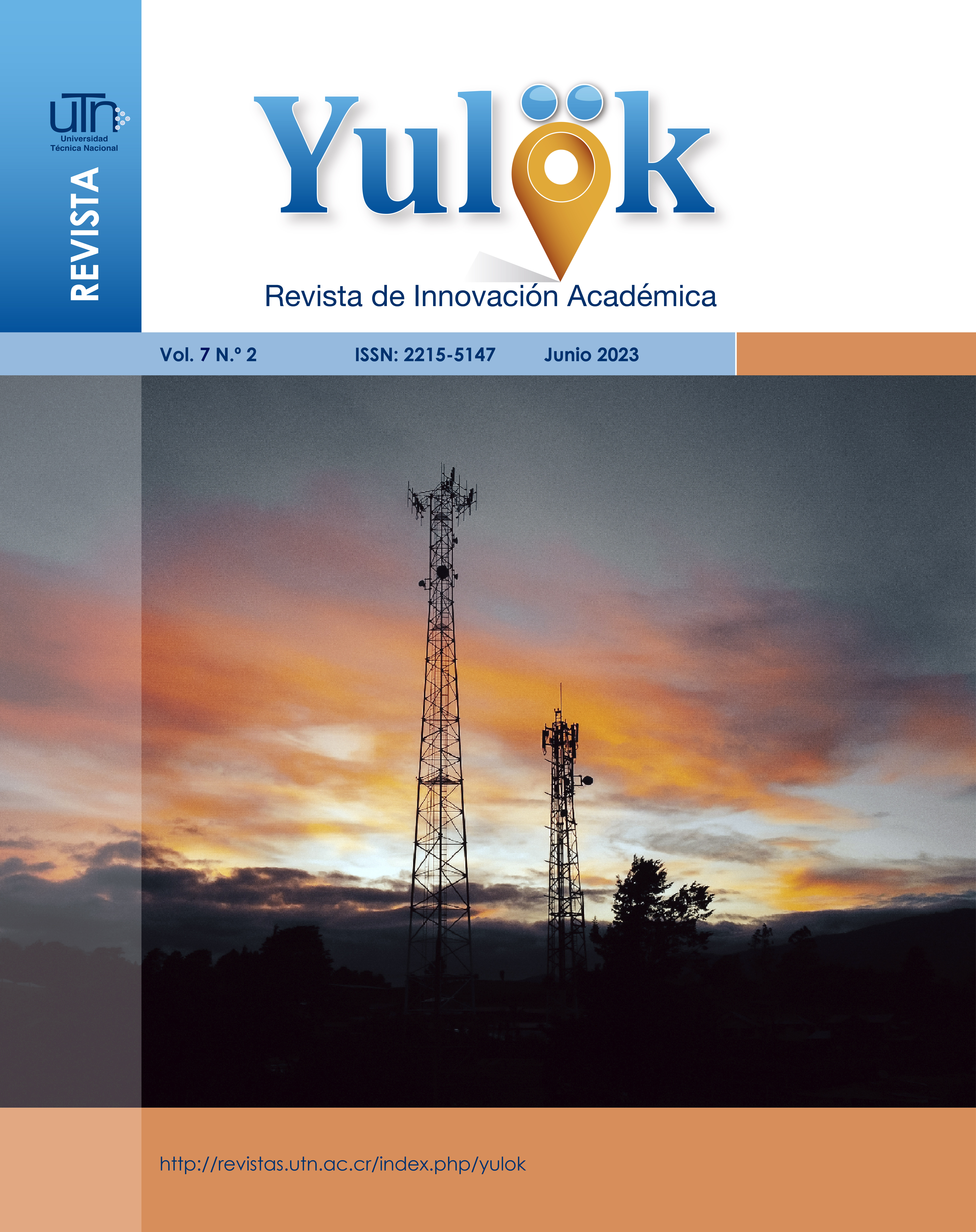Evaluación del co-compostaje de lodos cloacales con pulpa de café, para su aprovechamiento en Costa Rica
Contenido principal del artículo
Resumen
Con el fin de dar un aprovechamiento a los lodos cloacales en Costa Rica y realizar un primer co-compostaje de su clase en el país, se realizó un ensayo de co-compostaje por 150 días en la provincia de Heredia. Objetivo: Comparar el tratamiento de una mezcla de lodos cloacales con dos tipos de estructurantes, con y sin pulpa de café, evaluando las diferencias en el proceso y la calidad del producto final. Metodología: Los tratamientos con pilas aireadas aeróbicas consistieron en tres pilas testigo compostando lodo cloacal y restos de poda triturado como estructurante (T, % v/v 35% de lodo cloacal y 65% material estructurante) y tres pilas con un tratamiento de co-compostaje con pulpa de café (PL, % v/v 25% de lodo cloacal, material estructurante con 35% de pulpa de café y 40% de restos de poda triturado), creadas con un volumen aproximado de 3 m3; a las que se le realizaron ensayos físico-químicos (T, %H, pH, metales), microbiológicos (coliformes fecales, salmonella y helmintos), pruebas de madurez y estabilidad. Resultados: Muestran que ambos tratamientos logran un biosólido estable para su posterior uso agrícola. El co-compostaje de lodos cloacales en mezcla con pulpa de café cumple parámetros de calidad para su uso como enmiendas siendo clasificado como clase A según los parámetros de la U.S.EPA, sin encontrar diferencia en el análisis estadístico al comparar la evolución del proceso y ni en la calidad del producto final entre tratamientos (T y PL).
Detalles del artículo

Esta obra está bajo una licencia internacional Creative Commons Atribución-NoComercial-CompartirIgual 4.0.
Todos los artículos publicados están protegidos con la licencia Creative Commons Atribución-NoComercial-CompartirIgual 4.0 Internacional
![]()
Cómo citar
Referencias
Baird, R., & Bridgewater, L. (2017). Standard methods for the examination of water and wastewater. 23rd ed. Washington, D.C.: American Public Health Association.
Busquets, A., Turet , J., & Barrena, R. (2011). Respirometric screening of several types of manure and mixtures intended composting for composting. Bioresource Technology, 102, 1367-1377. doi:doi:10.1016/j.biortech.2010.09.011
Gobierno de la República de Argentina (2018). Norma técnica para el manejo sustentable de barros y biosólidos generados en plantas depuradoras de efluentes líquidos cloacales y mixtos cloacales-industriales.
Gobierno de la República de Costa Rica (2015). Reglamento para el Manejo y Disposición Final de Lodos y Biosólidos N° 39316-S. Recuperado de http://www.pgrweb.go.cr/scij/Busqueda/Normativa/Normas/nrm_texto_completo.aspx?param1=NRTC&nValor1=1&nValor2=80715&nValor3=102487&strTipM=TC
Gobierno de la República de Costa Rica (2016). Reglamento Técnico RTCR 485:2016 Sustancias Químicas, Fertilizantes y Enmiendas para uso agrícola, tolerancias y límites permitidos para la concentración de los elementos contaminantes N° 39994-MAG. Recuperado de http://www.pgrweb.go.cr/scij/Busqueda/Normativa/Normas/nrm_texto_completo.aspx?param1=NRTC&nValor1=1&nValor2=83141&nValor3=106622&strTipM=TC
Graedel, T., & Allenby, B. (2010). Industrial Ecology and Sustainable Engineering. Pearson.
Hafner, G., San Martín, M., & Reiser, M. (2018). Proyecto de Apoyo a la NAMA Café Bajo en Emisiones Costa Rica. GIZ. Stuttgart: GIZ.
Haug, R., 1995. Practical Handbook of Compost Engineering. Lewis Publishers, Boca Raton, FL.
Himanen, M., & Hänninen, K. (2011). Composting of bio-waste aerobic and anaerobic sludges-effect of feedstock on the process and quality of compost. Bioresource Technology, 2842-2852.
Kone, D., Cofie, O., Zurbrugg, C., Gallizzia, K., Moser, D., Drescher, S., & Strauss, M. (2007). Helminth eggs inactivation efficiency by faecal sludge dewatering and co-composting in tropical climates. Water Research, 41, 9397-4402. doi:10.1016/j.watres.2007.06.024
Mazzarino, M. & Kowaljow, E. (2007). Soil restoration in semiarid Patagonia: Chemical and biological response to different compost quality. Soil biology & biochemistry, 39(7), 1580-1588.
Lavado, R. S. 2012. Origen del compost, proceso de compostaje y potencialidad de uso. Pag 3-12 en M. J. Mazzarino y P. Satti, editoras. Compostaje en la Argentina: Experiencias de producción, calidad y uso. UNRN- Orientación Gráfica Editora, Buenos Aires.
Li, G., Sun, Y., Zhang, F., Wong, J., & Fang, M. (2001). Chemical evaluation of sewage sludge composting as a mature indicator for composting process. Water, Air, and Soil Pollution, 132: 333-345.
Mazzarino, M. J. & Satti, P. (2012). Compostaje en la Argentina: experiencias en producción, calidad y uso. Editorial UNRN & Orientación Gráfica Editora.
Mazzarino, M., Roselli, L., Satti, P. & Crego, M. (2015). Técnicas para análisis de compost (p. 25). Universidad Nacional del Comahue.
Metcalf & Eddy. (2014). Wastewater Engineering: Tratamiento y recuperación de recursos (Vol. 5th Ed.). (AECOM, Ed.) New York, USA: Mc Graw Hill.
OMS, & ONU. (2018). a. Progresos en el tratamiento y el uso de las aguas residuales de manera adecuada: Prueba piloto de la metodología de monitoreo y primeras constataciones sobre el indicador 6.3.1 de los ODS. ONU-HABITAT. Ginebra: ONU. Recuperado de http://apps.who.int/iris.
ONU. (2006). Global Atlas of Wastewater Sludge and Biosolids Use and Disposal: Mpving forward the sustainable and welcome uses of a global resource. (Second ed.). (ONU, Ed.) Moncton, Canada: ON-HABITAT.
Programa Estado Nación. (2018). Informe Estado de la Nación en Desarrollo Humano Sostenible 2017. ConsejPEo Nacional de Rectores. San José: CONARE. Recuperado de https://estadonacion.or.cr/informes/
Ramalho, R. (2016). Tratamiento de Aguas Residuales. Barcelona, España: Editorial Reverté.
Riera, N. (2019). Evaluación del manejo de residuos porcinos de un sistema intensivo y semi-intensivo. Su caracterización, estabilización y aplicación de efluente y compost sobre la matriz suelo y planta. [Tesis de doctorado inédita]. Facultad de Agronomía de la Universidad de Buenos Aires, Buenos Aires: UBA.
Rizzo, P. F. (2020). Análisis integral para el manejo del guano de aves ponedoras: caracterización, bioestabilización y valorización de los productos generados. [Tesis de doctorado inédita]. Facultad de Agronomía de la Universidad de Buenos Aires, Buenos Aires: UBA.
Román , P., Pantoja, A., & Martinez, M. (2013). Manual de compostaje del agricultor: Experiencias en América Latina. Santiago, Chile: FAO. Recuperado de http://www.fao.org/3/a-i3388s.pdf
TMECC, Test Methods for the Examination of Composting and Compost. 2002. USDA and U.S. Composting Council.
Tognetti, C., Mazzarino, M.J. & Laos, F. (2007). Improving the Quality of Municipal Organic Waste Compost. Bioresource Technology, 98, 1067-1076. http://dx.doi.org/10.1016/j.biortech.2006.04.025

